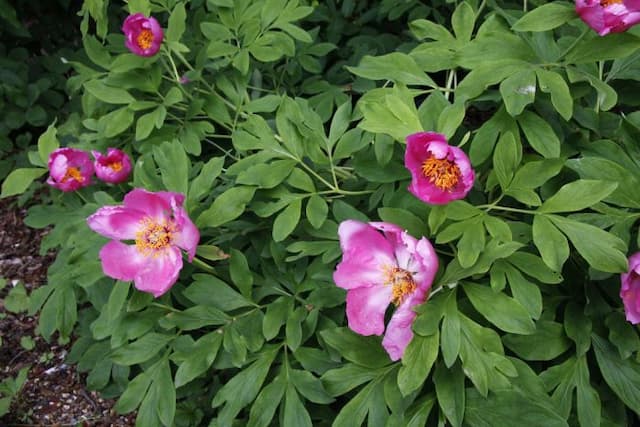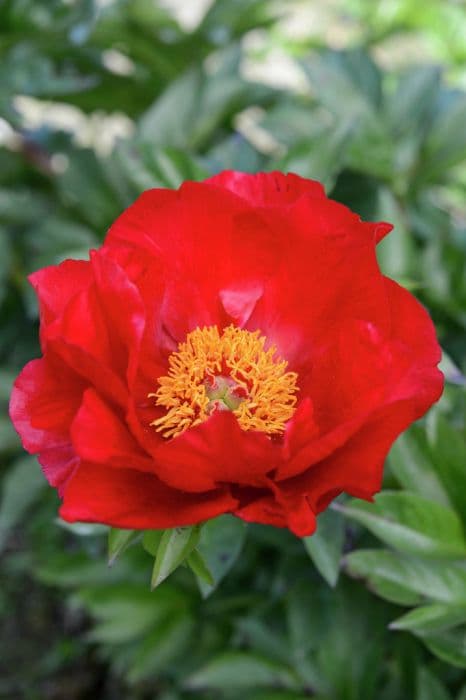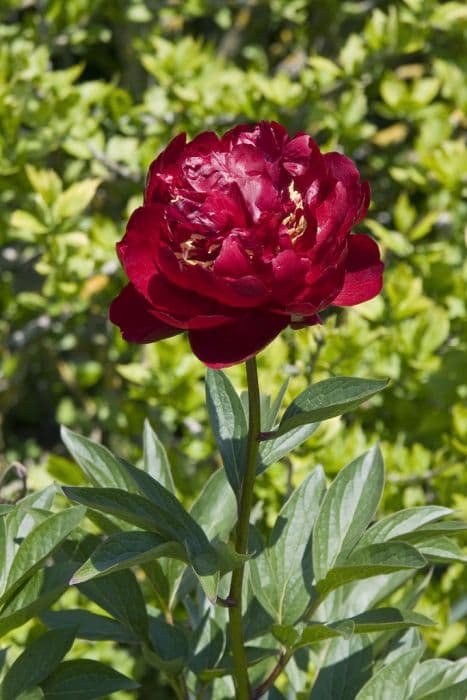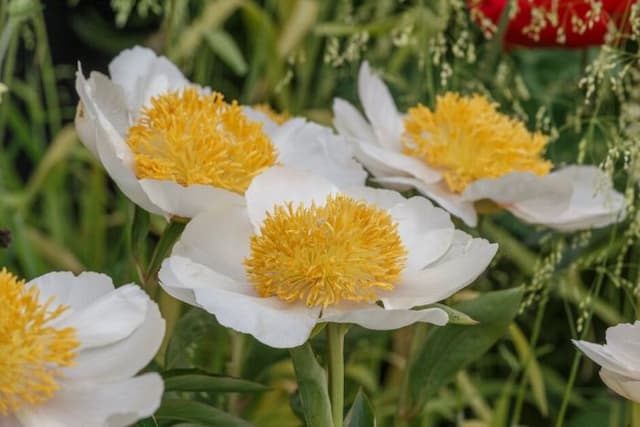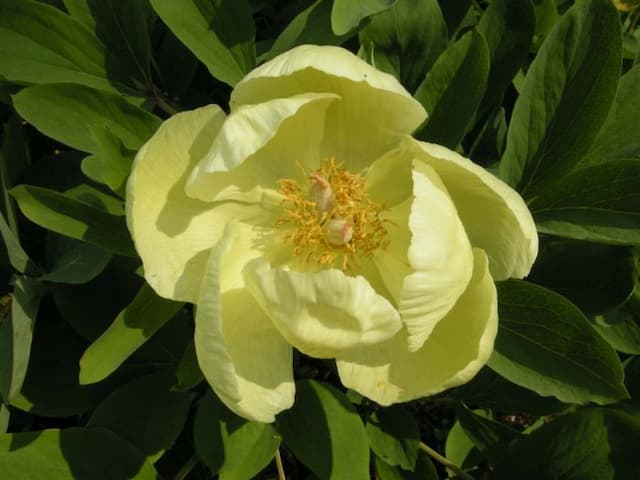Chinese peony Paeonia lactiflora 'Fen Yu Nu'

ABOUT
Paeonia lactiflora 'Fen Yu Nu', commonly known as Chinese Peony or White Peony, is a perennial flowering plant renowned for its stunning blooms and lush foliage. The plant produces large, double flowers that exhibit a soft, creamy white color with hints of blush pink, particularly at the petal bases. These blooms are renowned for their striking appearance, often showcasing a ruffled and full look, with layers upon layers of delicate, overlapping petals that create a fluffy, voluminous effect. Each flower is adorned with a golden center consisting of small, yellow stamens that add a touch of warmth to the overall cool palette of the blossoms. The flowers of the White Peony emit a sweet, pleasing fragrance, which attracts pollinators and adds to the sensory experience of the garden. The large blooms are supported by sturdy, green stems that rise up from the plant's base, branching out to hold the heavy flowers aloft. The foliage of White Peony further complements its flowers, with deeply lobed leaves that are lush and dark green. The leaves have a glossy sheen and provide a dense, rich backdrop to the more delicate floral display. In the growing season, the leaves form an attractive mound that fills out the plant and adds texture to garden landscapes. The luxurious and romantic aspect of the White Peony's flowers make it a favorite for ornamental gardens and is often used in bridal bouquets and floral arrangements for its aesthetic appeal and fragrance. As the seasons change, the plant's foliage may also exhibit autumnal color changes before dying back in winter, to reemerge with renewed vigor in the spring.
About this plant
 Names
NamesFamily
Paeoniaceae
Synonyms
Chinese Peony, White Peony
Common names
Paeonia albiflora Pall., Paeonia edulis Salisb., Paeonia officinalis var. albiflora (Pall.) Sabine & DC., Paeonia lactiflora var. trichocarpa (Bunge) Stapf.
 Toxicity
ToxicityTo humans
The Chinese Peony, which is the common name for Paeonia lactiflora 'Fen Yu Nu', is generally considered to have a low level of toxicity to humans. It is not commonly associated with serious poisoning when touched or ingested. However, consuming parts of this plant, particularly in large amounts, might lead to gastrointestinal upset, such as nausea, vomiting, and diarrhea. As with any non-food plant, it is advisable to avoid ingesting parts of the Chinese Peony to prevent any potential adverse effects.
To pets
Chinese Peony, or Paeonia lactiflora 'Fen Yu Nu', is considered to have a low level of toxicity to pets. While it is not typically known for being highly poisonous, ingestion of parts of this plant can potentially cause mild gastrointestinal upset in pets, such as vomiting or diarrhea. It is recommended to keep pets from consuming any parts of the Chinese Peony to avoid any possible discomfort or digestive issues.
 Characteristics
CharacteristicsLife cycle
Perennials
Foliage type
Deciduous
Color of leaves
Green
Flower color
Pink
Height
2-3 feet (0.6-0.9 meters)
Spread
2-3 feet (0.6-0.9 meters)
Plant type
Herb
Hardiness zones
3-8
Native area
Asia
Benefits
 General Benefits
General Benefits- Ornamental Value: Paeonia lactiflora 'Fen Yu Nu', commonly known as the Chinese Peony, has large, fragrant flowers that make it a popular choice for ornamental gardens and cut flower arrangements.
- Landscape Design: They can be used to create beautiful borders or as focal points in garden beds, and their lush foliage provides a green backdrop for other plants.
- Extended Blooming Season: Chinese Peonies have a relatively long blooming period in late spring to early summer, offering visual interest for an extended time.
- Attracts Pollinators: The blossoms attract bees and other pollinators, thus contributing to the health of the garden ecosystem.
- Hardiness: These plants are hardy in a range of climates and can survive cold winters, making them suitable for gardens in many regions.
- Low Maintenance: Once established, Chinese Peonies require minimal care, needing only occasional watering and fertilizing to thrive.
- Drought Tolerance: They are relatively drought-tolerant, which makes them a good choice for gardens in areas with water restrictions or less frequent rain.
- Variety of Colors: The flowers come in a range of colors from white to pink to red, providing a broad palette for garden design.
- Perennial Growth: As a perennial plant, Chinese Peonies come back year after year, offering long-term value for gardeners.
- Heritage and Tradition: Chinese Peonies have been cultivated for centuries, carrying cultural significance and a sense of heritage in the garden.
 Medical Properties
Medical Properties- Anti-inflammatory: Paeonia lactiflora 'Fen Yu Nu', commonly known as white peony, may possess compounds that reduce inflammation and might be used in treating conditions associated with inflammation.
- Analgesic: The roots of the white peony have been traditionally used for their potential pain-relieving properties.
- Antispasmodic: White peony may help in relieving muscle spasms and could be utilized in addressing menstrual cramps and muscle tension.
- Immunomodulatory: Extracts from white peony could potentially modulate the immune system, which might be helpful in regulating immune responses.
- Antioxidant: The roots may contain antioxidants, which combat oxidative stress and may protect cells from damage caused by free radicals.
 Air-purifying Qualities
Air-purifying QualitiesThis plant is not specifically known for air purifying qualities.
 Other Uses
Other Uses- Art and Photography: The Paeonia lactiflora, commonly known as the Chinese peony, is often used in art and photography for its beauty and aesthetic appeal, mainly due to its large, lush flowers.
- Culinary Decoration: Petals of the Chinese peony can be used to decorate cakes and desserts, giving them an elegant and colorful touch.
- Textile Dyes: The petals of Chinese peony can be used to produce natural dyes for fabrics, offering a range of pink hues depending on the concentration and processing method.
- Wedding Decor: The full blooms of the Chinese peony are popular choices for wedding bouquets and venue decorations due to their romantic appearance and variety of colors.
- Garden Design: Chinese peony plants are used in landscaping to create stunning garden displays and to serve as focal points in perennial borders.
- Floral Crafts: Dried petals and blooms of the Chinese peony can be incorporated into potpourris, wreaths, and other floral crafts to bring a touch of nature indoors.
- Educational Tool: The Chinese peony can be used in botany and horticulture education as an example of plant breeding, genetics, and hybridization processes.
- Cultural Symbolism: Used as a cultural symbol in traditional Chinese festivals and art, the Chinese peony often represents wealth, honor, and high social status.
- Perfumery: While not commonly used in commercial perfumery, the faint fragrance of Chinese peony flowers can inspire natural and homemade scents.
- Relaxation Spaces: Planting Chinese peonies in public gardens and parks creates a serene and inviting environment for visitors to relax and unwind.
Interesting Facts
 Feng Shui
Feng ShuiThe Peony is used in Feng Shui to promote romance and prosperity; it is often used in the southwest area of a garden or home to attract love and in the southeast for wealth.
 Zodiac Sign Compitability
Zodiac Sign CompitabilityThe Peony is not used in astrology practice.
 Plant Symbolism
Plant Symbolism- Prosperity: Paeonia lactiflora, commonly known as the peony, is often associated with wealth and honor. This symbolism originates from its full, round blossoms which are reminiscent of coins, suggesting abundance and prosperity.
- Honor: In many cultures, peonies are a symbol of honor and high social status, often used in important ceremonies and to show respect.
- Beauty: The peony, with its large and attractive flowers, symbolizes beauty in all its forms, including physical attractiveness and the beauty of one’s character.
- Richness: The lush, dense petals of the peony are indicative of richness—not just materially but also a rich and fulfilling life.
- Romance: The peony is a traditional floral symbol of love and romance, often used in wedding bouquets and decorations to signify a happy marriage.
- Good Fortune: Peonies are believed to bring good luck and fortune, making them popular gifts for new ventures and celebratory events.
- Happy Life: The fullness of the peony bloom is also symbolic of a happy life filled with good moments and pleasures.
 Water
WaterPeonies like the Paeonia lactiflora 'Fen Yu Nu' should be watered deeply once a week during their growing season, especially if the weather has been dry. Each plant should receive about 1 inch of water, which equates to roughly 0.6 gallons for each plant. In the absence of rain, maintain this watering schedule to ensure a deep watering that reaches the roots, as shallow watering will not suffice for these deep-rooted plants. Decrease watering after they have finished blooming, as peonies are somewhat drought tolerant and excessive water can lead to root rot.
 Light
LightPeonies such as the Paeonia lactiflora 'Fen Yu Nu' flourish best in full to partial sun, meaning they should receive 6-8 hours of sunlight daily. The ideal spot for these peonies would be a location that enjoys bright morning sun and some shade or filtered light during the hottest part of the afternoon to protect blooms from fading.
 Temperature
TemperaturePeonies like Paeonia lactiflora 'Fen Yu Nu' can survive winter temperatures as low as -20°F and prefer a climate with cold winters for proper dormancy, with an ideal growing temperature range between 65°F to 75°F during the growing season. They can handle summer temperatures up to 85°F without distress, but prolonged heat may impact their flowering.
 Pruning
PruningPrune peonies like Paeonia lactiflora 'Fen Yu Nu' to remove spent flowers after they bloom to maintain appearance and prevent seed formation, which can divert energy from the plant. In fall, after the leaves have died back, cut back the stems to about 3 inches above ground level to help prevent disease. Pruning is typically done annually, during those two specific times.
 Cleaning
CleaningAs needed
 Soil
SoilThe common peony requires well-draining soil with a rich mix of organic matter. Aim for a soil pH of 6.5 to 7.0. Mixing in compost and a little sand can help achieve the ideal texture and fertility for this plant.
 Repotting
RepottingPeonies like Paeonia lactiflora 'Fen Yu Nu' seldom need repotting as they prefer to be left undisturbed. They can thrive in the same spot for up to 10-15 years as long as the soil remains fertile and well-drained.
 Humidity & Misting
Humidity & MistingPeonies, including Paeonia lactiflora 'Fen Yu Nu', are tolerant of a wide range of humidity levels and prefer average ambient humidity found in most outdoor environments.
 Suitable locations
Suitable locationsIndoor
Peonies struggle indoors; they require chilling and space.
Outdoor
Plant in full sun, rich soil, space roots well, water deeply.
Hardiness zone
3-8 USDA
 Life cycle
Life cyclePaeonia lactiflora 'Fen Yu Nu', commonly known as Chinese Peony 'Fen Yu Nu', begins its life cycle as a seed, which under suitable conditions, will germinate and develop a small root system and shoot. This perennial plant then enters a vegetative stage, producing leaves and stems as it accumulates resources through photosynthesis. As it matures, the peony prepares for flowering, which typically occurs in late spring to early summer, showcasing large, fragrant flowers that can range in color. After pollination, which can be aided by insects, the plant develops seed pods which eventually release seeds once they mature and dry, repeating the reproductive cycle. During autumn, the foliage dies back as the plant enters dormancy to conserve energy through the winter. As spring arrives, the plant breaks dormancy, and new shoots emerge from the rootstock, heralding the start of a new growth cycle.
 Propogation
PropogationPropogation time
Spring-Early Summer
The common name for Paeonia lactiflora 'Fen Yu Nu' is the Chinese peony, and the most popular method of propagation for this plant is by division. Division is typically done in the fall, after the plant has finished flowering and as it starts to go dormant. To divide a Chinese peony, carefully dig up the plant and shake or rinse off the soil to reveal the root system. Look for natural divisions and gently separate the root clumps, ensuring that each division has at least three to five eyes, which are the pink or white buds on the roots from which new shoots will emerge. Replant each division so that the eyes are no deeper than 2 inches (approximately 5 centimeters) below the soil surface. Water the new plantings thoroughly to help them establish. This method not only helps to propagate the plant but also invigorates older clumps that may be suffering from diminished blooming.
